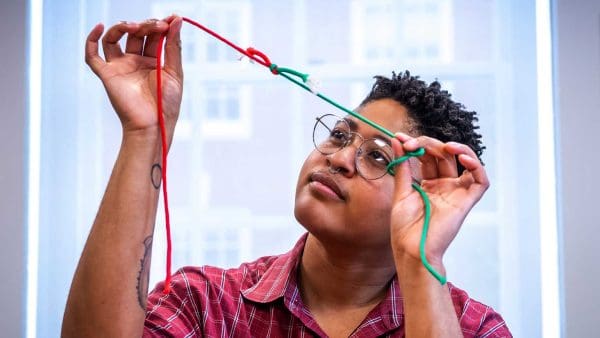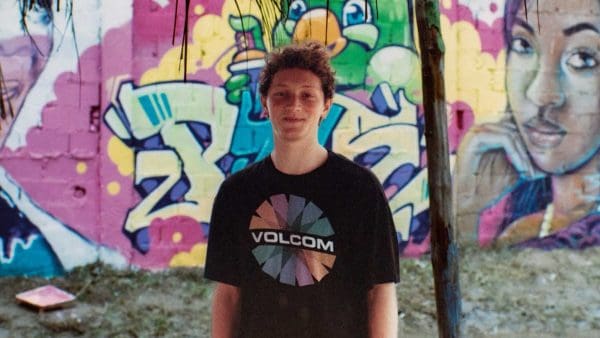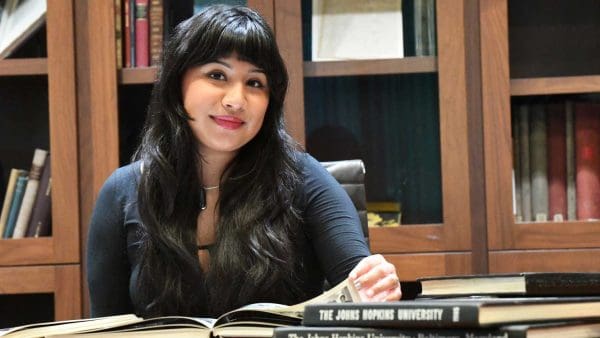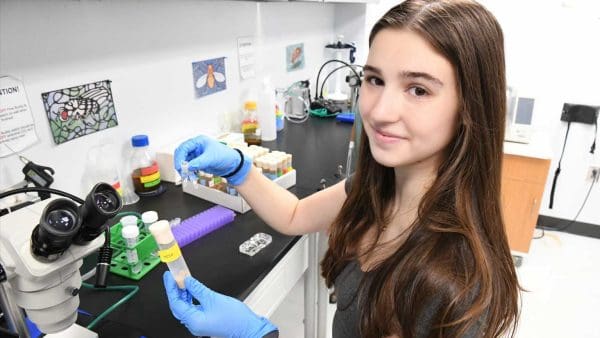Learned Scribbles
Junior Anna-Astrid Oberbrunner spent a good chunk of last summer holed up in a windowless room with “a beautiful and fascinating object.” That’s how she describes a copy of Virgil’s works printed in Venice in 1507 that was recently added to the university’s rare book collection. Though worms have gnawed tiny holes here and there and at some point over the centuries the tome ignobly did duty as a drink coaster (at least, the ring stains suggest as much), for a classics major who’s been studying Latin since high school, the hoary volume is mental catnip.
“It’s always cool to work with an artifact,” says Oberbrunner, recipient of a Dean’s Undergraduate Research Award. “This is kind of the perfect project for me because it’s translation but it’s also, in a sense, archaeology.”
But she’s not interested so much in the printed words of the ancient Roman poet who died more than 2,000 year ago, but rather the handwritten annotations accompanying them. There are notes in various hands scrawled in the margins and even doodles throughout the book. (Picture the condition of a used English lit anthology making the rounds today, minus the yellow highlighting.) Of particular interest are some 20 pages of tightly scrawled Latin sewed into the front of the book and attributed to Benedictus Philologus, a 16th-century Florentine scholar.
“It’s unclear how the inserted pages actually relate to the book itself, which is going to be one of the things I try to figure out,” she says. “As far as we know, they’ve never been translated.”
Her first task has been to transcribe all the handwriting into her computer, a challenge because the author used all manner of abbreviations and verbal shortcuts that have to be figured out. The process of translating the Latin into English is ongoing. “I’d like to understand who was using the book and for what,” Oberbrunner says. “Was it a teaching tool? Did it belong to some scholar who was using it for his work? Is this a personal copy?”
Figuring out what Philologus and the others who penned notes and commentary in the book were saying about Virgil’s Aeneid and his other pre-Christian writings will hopefully also say something about the Renaissance era in which they wrote them. “It’s like looking into like a funhouse mirror,” Oberbrunner says. “You can see what this person is thinking reflected in what they thought was interesting to them about antiquity.”
Saving Memories

“Working with veterans, I would hear some incredible stories,” the junior neurology major says. But there was a sadness to it all as well. These patients—most in their 70s and 80s—had profound cognitive impairment. “They wouldn’t remember me or my face, and I would always have the same conversation with the same people,” Bhammar says. “They’d be happy to see a new face even though they’ve been seeing me every day for two months.” And Alzheimer’s—now the sixth leading cause of death in the country—is degenerative and fatal.
This interest in seniors, combined with a long fascination with the human brain—what Bhammar calls, “a universe saturated with mysteries”—has him aiming for a career in geriatric neurology. And it’s also why he’s doing research in Professor Michela Gallagher’s lab in the Department of Psychological and Brain Sciences, which is focused on neurocognitive aging. His research is made possible with support from the Phyllis F. Albstein Fund.
In the lab, Bhammar no longer works with seniors, but instead, with rats standing in for humans. The rodents are separated into three categories: young rats, older rats that don’t show any cognitive impairment, and older rats that do show impairment. (The rodents are subject to a memory test of sorts in a pool of water to determine their cognitive state.) It’s Bhammar’s job to examine the thinly sliced brains of all three types of rats looking for differences across the groups.
What to look for? Well, our brains operate with a balance between neural excitation (a lot of synaptic activity) and inhibition (reduced synaptic activity). Might age-related cognitive impairment be the result of an excitation/inhibition imbalance? Gallagher’s most significant finding to date suggests as much, as she’s shown that excessive hyperactivity in one section of the hippocampus may account for memory loss. Bhammar examines brain slices that have been dyed to make the presence of certain genes stand out—genes whose presence in small amounts or greater amounts model whether a section of the brain was subject to excitation or inhibition. So far, preliminary findings indicate that brains of older rats without cognitive impairment show increased neural inhibition.
“This is all a hypothesis at this point, but in order to maintain successful cognition you may need to increase the amount of inhibition in certain areas of the brain,” Bhammar says. “When those ratios go haywire—that’s what could lead to cognitive impairment. But we’ve got a long way to go before we can actually conclusively say that.”
Rice to the Rescue

Rice was certainly a mealtime staple for Afranie growing up in her native Ghana, with dishes like spicy rice jollof and the rice-and-beans combo, waakye. “I’ve eaten rice for breakfast, lunch, and dinner before,” she says. It led her to write a 17-page literature review in her senior year of high school that examined potential chemopreventive properties of rice and how a rice diet might reduce breast cancer risk.
“I found that there are some properties in rice that do reduce breast cancer risk,” says Afranie, who also noticed that Africa—like Asia—has both higher rice consumption and lower rates of breast cancer compared with North America. Now double majoring in public health and international studies, she’s hoping she can take her rice research to the next level.
Her research project is still in the early stages, though as a first step she’s narrowed the focus to look at the grain’s ability to lower estrogen levels. (Studies have shown that higher levels of estrogen in the blood can increase breast cancer risk.) Over the next couple of years she wants to travel to Asia and Africa and establish a dietary study.
“I will set up test groups of women where I can measure their diets,” says Afranie, recipient of a Woodrow Wilson Fellowship. “Basically, I’ll have these groups consume brown rice for a couple of weeks while I measure their estrogen levels over time to see if the consumption of rice is limiting estrogen production or estrogen circulation in the body.”
China Courts Africa

Senior Léandre Eberhard (left), finishing up an extra semester so he can add a math major to his others (economics, international studies, and German), wondered if there was more to the story. He used funds from a Woodrow Wilson Fellowship to find out.
“What I want to quantify is if Chinese investment in Africa creates more commerce overall between African countries and the world,” he says.
Eberhard wrote a statistical computing program using the programming language R. It uses a least absolute shrinkage and selection operator—a type of regression abbreviated to LASSO—designed to weed through the reams of trade and investment data available from the World Bank and Chinese Ministry of Commerce.
“LASSO is actually a technique that I learned in a class last semester called Big Data,” Eberhard explains “Essentially, what it does is it selects variables for you. And using that gives you more measurable data you can actually interpret.”
So far he’s found that Chinese investment does not appear to increase African trade with other nations. “The current results seem to support the standard opinion that people have in the West that Chinese investment in Africa is mostly benefiting China.” One acknowledged potential shortcoming to his finding might be its use of only six years of trade data, from 2004 to 2010. But the beauty of his research is that it created a tool he can now use for other purposes.
“The hard part is done,” he says. “The code is written so all I have to do now is give it new data.” He’s already working on feeding the program data about Chinese investments in Pakistan and the Middle East.
Eberhard has found the process of self-guided research was reward in itself.
“It’s just so different from class work where you’re given an assignment and you just finish that and then you’re done with it,” he says of his research. “You have to make your own assignments and ask questions of yourself without knowing if there’s a correct answer. I’m really glad that I’m able to do this before actually being a graduate student or a PhD student.”




